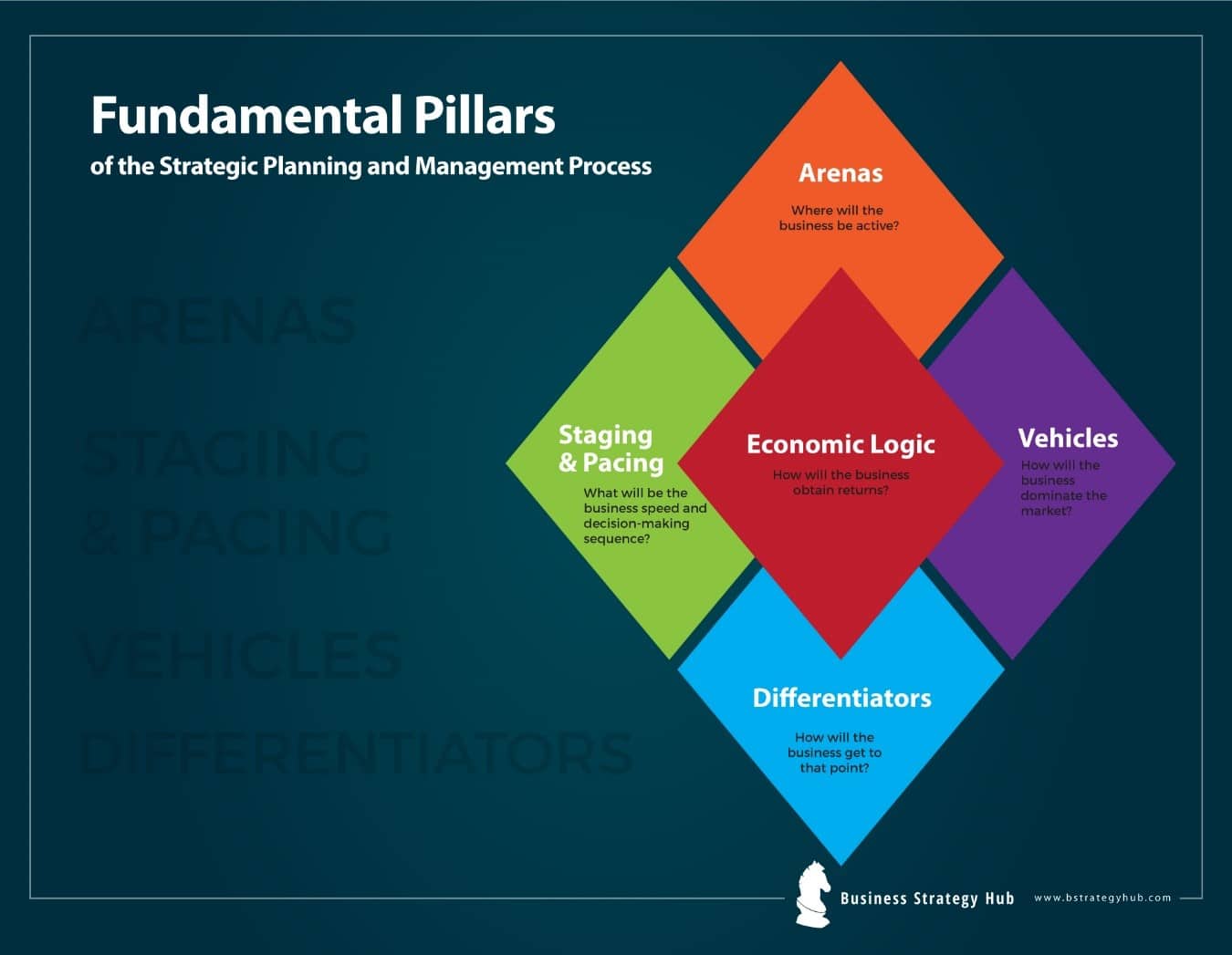Last updated: Feb 22, 2020
Model Name: Strategy Diamond
Creator: Donald Hambrick and James Fredrickson
Year: 1990
Purpose: strategic planning | new market entry analysis | new product introduction | new business opportunity analysis | how to grow | turnaround strategy | company position assessment | profitability | competitive analysis | market development | market penetration | diversification
There is a hypothetical playing field in the realm of business, in which every company, large and small, must operate.
Into this playing field, businesses are born. In that environment, they learn to operate and to compete.
You may have noticed that within the very same playing field, some companies go very far and keep winning.
Meanwhile, others soon fall behind or grind to a halt in terms of growth. And then there are those businesses which can’t keep up at all and are forced to leave the field altogether.
So how do you get your business to reach the front line in the playing field, and rank among the successful players?
You can hope for the best, or you can get on your feet and focus on effective strategies to take it to that level yourself.
You need a diamond-hard strategy
As long as we are using sports anecdotes, picture a baseball “diamond” or field.
The same way that players have to run across each base to score a home run, your business must follow the rules of the game in a strategic way to get ahead.
“Strategic planning is an integrated, externally oriented model that determines how a business will achieve its objectives, and contend against its opponents”
There are countless tools, approaches, and methodologies out there that help businesses arrive at their ultimate strategies, and guide the execution of said strategies to completion.
One of these is the Strategy Diamond. Donald Hambrick and James Fredrickson asked a question in the form of a world-famous article: Are you sure you have a strategy?
In it, they defined and outlined the strategy diamond as a firm, sound way of envisioning, scrutinizing, encapsulating, and sharing one’s strategy for their product or business.
Cutting out the strategy

The diamond shape of the strategy serves as an ideal model on which to identify and mark the different dimensions of microeconomic competition that your business is fated to face.
Every strategy is a unison of an integrated set of business choices, relating to five elements which are considered during the decision-making process:
(1) Arenas: where will the business be active?
(2) Differentiators: How will the business get to that point?
(3) Vehicles: How will the business dominate the market?
(4) Staging and pacing: What will be the business speed and decision-making sequence?
(5) Economic logic: How will the business obtain returns?
These aspects form the fundamental pillars of the strategic planning and management process. These elements also make up the strategy diamond itself.
With most strategy tools and plans, the focus is mainly on one or two of the elements, which means the outcome is an incomplete strategy with large, overlooked gaps.
The strategy diamond asks the answers to all five questions to ensure fully integrated, all-inclusive, strategic planning.
Follow the Diamond
Arenas
Arenas are all “locations” where your business will activate.
Studying the arena will allow you to determine not only the geographic segments but also the industry groups where the firm will compete.
Ask these questions in the arena element of the strategy diamond:
- What core technologies will we have?
- In which geographic locations will we activate?
- Which market segments will we enter?
- Which product categories will we introduce?
- What kind of activities can be outsourced to another location?
EXAMPLE OF PACIFIC CYCLE
Take the example of Pacific Cycle, America’s largest bicycle distributor. Pacific Cycle sells bikes via retail outlets, independent dealers, and free agents in foreign markets. Pacific Cycle also outsources all production to manufacturers in Asia, the established hub of low-cost, high-quality manufactured goods.
Differentiators
This element defines the attributes and specifications of your products or services which allow it to defeat market rivals.
The sooner and more consistently your business drives its chosen differentiators, the more likely it is that customers will recognize and choose your offerings over your competition’s.
Consider the following questions, when choosing your differentiators:
- What is our technological advantage?
- How is the quality of our product/service?
- What is our product/service pricing?
- How is our company perceived in the industry, its overall image?
- What is our standard of product reliability?
The two critical dynamics surrounding the selection of differentiators are:
- Early, up-front decisions are crucial.
- Making tough choices about trade-offs is inevitable.
EXAMPLE OF AUDI
Consider Audi, which aligns these two dynamics successfully for selecting optimized differentiators. Audi management realized early on that its cars were considered expensive yet low-quality automobiles.
The company decided to move up in the market by investing heavily in refined marketing efforts and quality improvement programs rather than by lowering its price range. In a matter of years, Audi cars began to be perceived as high-quality vehicles, almost at the level of Mercedes-Benz and BMW.

Image Source: www.goauto.com.au
Vehicles
Vehicles enable firms to partake in the targeted arenas. It is simply the means by which your company aims to secure the industries and geographic areas it targets in the beginning of the strategy diamond.
Other “vehicle” examples are:
- Investing in research and development
- Licencing/franchising
- Forming an alliance with a competitor or supplier
- Buying firms that own the technology or expertise you wish to acquire for your business
Staging and Pacing
Staging choices mirror the firm’s industry knowledge, human capital, and cash resources. Also, staging decisions are driven by the level of urgency and extent of business credibility.
Few firms have the resources to pace their strategies to be executed immediately. Usually, you have to match your opportunities to the resources available at the time.
Nor is every opportunity constantly available, many just appear as brief windows. However, you can estimate your own pace in the meanwhile by pondering the following questions:
- What is our speed of expansion?
- What is our speed of initiatives?
Economic Logic
This element simple determines how the firm will earn a profit by generating returns beyond its cost of capital.
When analyzing your company’s economic logic, costs and revenues both need to be considered, because economic logic can lie entirely on either side of the equation. In some cases, economic logic lies in significantly lowering your costs as compared to any major competitor. Elsewhere, economic logic may lie in convincing customers to willingly pay premium prices for your products.
So ask these questions:
- Can we lower costs by scale?
- Should we lower costs through scope or replication?
- Can we keep premium prices for an unparalleled service?
- Should we keep premium prices for exclusive product features?
Final Thoughts
Align these five elements that makeup business strategy and they will mutually reinforce to deliver you an all-encompassing tool for fundamental strategic planning.
Whatever strategy you execute, will prove itself in terms of performance levels. High performing strategies are embraced and implemented in business operations, while low performing strategies are discarded.
References & more information












Add comment